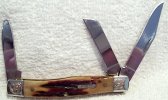waynorth
Knifemaker / Craftsman / Service Provider
- Joined
- Nov 19, 2005
- Messages
- 32,386
There is a real nice thread nearby show"Case"-ing Red Bone knives. Did you know that Case also produced Red Stag knives??
Much more rare, they are often quite beautiful. Here is the nicest one I've ever seen, belonging to our friend Mark. A great pattern, from a stellar era!
Keep your chin away from the keyboard!!!

As Jeff has done below, please show them if you've got them!!
Much more rare, they are often quite beautiful. Here is the nicest one I've ever seen, belonging to our friend Mark. A great pattern, from a stellar era!
Keep your chin away from the keyboard!!!

As Jeff has done below, please show them if you've got them!!
Last edited:











